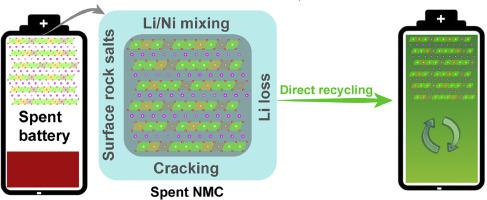废锂电池镍锰钴氧化物(NMC)阴极直接回收利用的进展
IF 20.2
1区 材料科学
Q1 CHEMISTRY, PHYSICAL
引用次数: 0
摘要
随着锂离子电池(LIB)在便携式电子产品和电动汽车(EV)中的广泛使用,在可持续发展情景下,预计到 2040 年,锂离子电池的报废量(EOL)将达到 1336 千兆瓦时。目前迫切需要进行适当的回收,以尽量减少危险废物的排放,并通过将关键矿物重新引入供应链来减少采矿活动。锂镍锰钴氧化物(LiNixMnyCozO2,NMCs)阴极已成为锂离子电池市场的主导,特别是随着电动汽车产量的不断增加,这也是 EOL 锂离子电池中最有价值的成分。火法冶金和/或湿法冶金方法将废 NMCs 转化为金属或金属化合物,与此不同,直接回收技术旨在通过恢复废阴极退化的结构和成分,最大限度地提高其价值。本综述总结了过去十年间发表的直接循环利用 NMC 阴极的方法,并对直接循环利用技术面临的挑战和未来的发展提出了见解。本文章由计算机程序翻译,如有差异,请以英文原文为准。


Progress in direct recycling of spent lithium nickel manganese cobalt oxide (NMC) cathodes
With the widespread use of lithium-ion batteries (LIBs) in portable electronics and electric vehicles (EVs), the end-of-life (EOL) LIBs are projected to reach 1336 GWh by 2040 under the sustainable development scenario. Proper recycling is urgently needed to minimize the release of hazardous waste and reduce mining activities by reintroducing critical minerals into the supply chain. Lithium nickel manganese cobalt oxide (LiNixMnyCozO2, NMCs) cathodes have become dominant in the LIB market, especially with the increasing production of EVs, which are also the most valuable components in EOL LIBs. Unlike pyrometallurgical and/or hydrometallurgical methods, which convert spent NMCs into metals or metal compounds, direct recycling technologies aim to maximize the value of spent cathodes by restoring their degraded structure and composition. This review summarizes direct recycling methods for NMC cathodes published in the last decade and provides insights into the challenges and future development of direct recycling techniques.
求助全文
通过发布文献求助,成功后即可免费获取论文全文。
去求助
来源期刊

Energy Storage Materials
Materials Science-General Materials Science
CiteScore
33.00
自引率
5.90%
发文量
652
审稿时长
27 days
期刊介绍:
Energy Storage Materials is a global interdisciplinary journal dedicated to sharing scientific and technological advancements in materials and devices for advanced energy storage and related energy conversion, such as in metal-O2 batteries. The journal features comprehensive research articles, including full papers and short communications, as well as authoritative feature articles and reviews by leading experts in the field.
Energy Storage Materials covers a wide range of topics, including the synthesis, fabrication, structure, properties, performance, and technological applications of energy storage materials. Additionally, the journal explores strategies, policies, and developments in the field of energy storage materials and devices for sustainable energy.
Published papers are selected based on their scientific and technological significance, their ability to provide valuable new knowledge, and their relevance to the international research community.
 求助内容:
求助内容: 应助结果提醒方式:
应助结果提醒方式:


